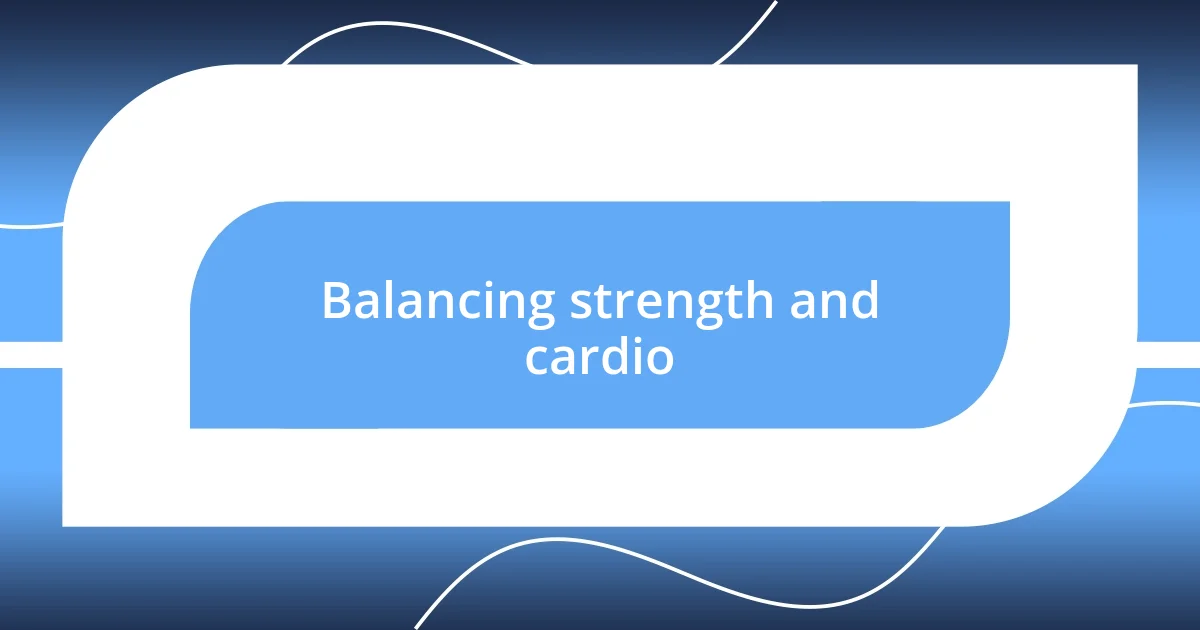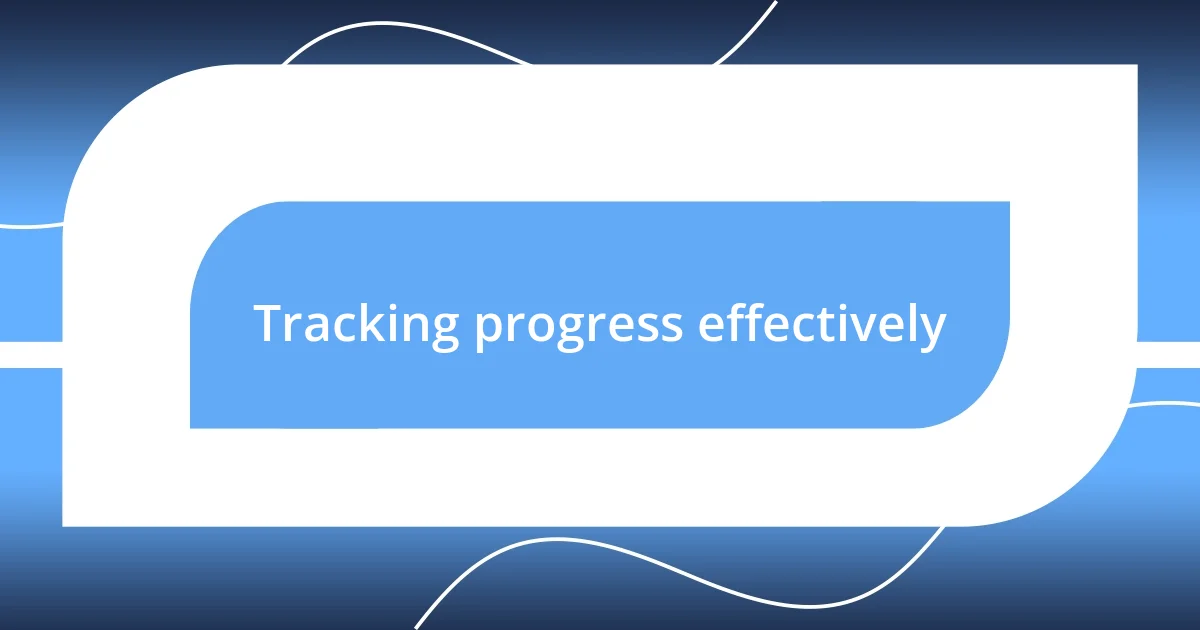Key takeaways:
- Setting specific and measurable fitness goals enhances focus and motivation, leading to more purposeful workouts.
- Incorporating progressive overload and balancing strength and cardio workouts are essential for continuous improvement and overall fitness.
- Regularly evaluating and adjusting workout routines based on progress and feedback from the body helps overcome plateaus and maintain motivation.

Understanding workout optimization
Understanding workout optimization is all about tailoring your exercise regimen to achieve the best results in the least amount of time. I remember the early days of my fitness journey when I’d jump into any workout without a plan, thinking that effort alone was enough. Have you ever felt like you were putting in the hours but not really seeing the progress? That’s a common experience!
One crucial aspect of optimizing workouts is recognizing the importance of goal-setting. For instance, when I switched from vague notions of “getting fit” to specific goals like “increasing my bench press by 20 pounds in three months,” my focus sharpened, and my workouts became more purposeful. This clarity has helped me prioritize exercises that align directly with my objectives.
Another element I consider is recovery. I once pushed myself too hard, believing that more was always better, only to find myself burnt out and underperforming. Have you ever pushed through fatigue, thinking you were building strength, only to feel weaker instead? Now, I’ve learned to embrace rest days and active recovery, which makes my workouts more effective. It’s about finding that sweet spot where effort meets recovery, allowing me to come back stronger each session.

Setting clear fitness goals
Setting clear fitness goals is essential for keeping motivation high and ensuring progress in your workouts. I’ll never forget the shift in my perspective when I learned to write down specific targets. Instead of vaguely aiming for “healthier eating,” I focused on “prepping meals every Sunday” or “running a 5K in under 30 minutes.” This clarity not only guided my routine but also ignited a sense of accomplishment with each milestone I hit.
To set effective fitness goals, consider these steps:
- Be Specific: Choose precise targets, like lifting a certain weight or running a specific distance.
- Make It Measurable: Track your progress over time to stay accountable.
- Set Realistic Timelines: Give yourself a reasonable timeframe to achieve each goal.
- Break It Down: Divide larger goals into smaller, manageable tasks. This prevents feeling overwhelmed.
- Reassess Regularly: Life changes, and so should your goals; give yourself the flexibility to adjust them as necessary.
When I started hitting my short-term milestones, I experienced a fulfillment I didn’t expect, fueling my determination to reach bigger challenges. A realistic and well-structured approach has empowered me — it’s like having a personal roadmap for my fitness journey.

Choosing the right exercises
Choosing the right exercises can feel overwhelming with countless options available, but I’ve found a systematic approach that works wonders for me. I assess my fitness goals and then match exercises that complement those objectives. For example, when I wanted to improve my endurance, I incorporated more cardio-focused sessions, like running and cycling. The better aligned my exercises were with my goals, the more progress I noticed.
I also emphasize variety in my workouts—it keeps me engaged and challenges my muscles in different ways. Recently, I added circuit training to my routine, combining strength exercises with minimal rest. This change not only spiced things up but also boosted my overall fitness. Have you ever tried mixing things up? I think it significantly reduces workout burnout and keeps me excited for my next session.
Lastly, I consider personal enjoyment as a crucial factor in exercise selection. When I gravitate toward activities I love, like dance or hiking, I find it easier to stay committed. I remember dreading gym sessions filled with exercises I disliked. Now, by prioritizing fun, I’ve turned my workouts into something I actively look forward to rather than a chore. When you choose exercises that resonate with you personally, the commitment naturally follows.
| Exercise Type | Alignment with Goals |
|---|---|
| Cardio (e.g., Running, Cycling) | Improves endurance and cardiovascular health |
| Strength Training (e.g., Weightlifting) | Builds muscle and boosts metabolism |
| Flexibility (e.g., Yoga) | Enhances mobility and recovery |
| Circuit Training | Combines cardio and strength for efficiency |
| Sports (e.g., Tennis, Basketball) | Makes workouts fun and social while improving agility |

Incorporating progressive overload
Incorporating progressive overload into my workouts has been transformative. I remember the first time I consciously increased my weights—every rep felt tough, but I reveled in that challenge. It’s no secret that to build strength and endurance, one must continually push the limits just a little bit more each week. Have you ever felt that sense of pride when you lift more than you thought possible? It’s truly exhilarating.
I frequently adjust not only the weights but also the number of sets and repetitions. Once, I was stuck in a routine, doing the same three sets of ten for months. When I finally decided to change it up—adding an extra set and mixing in drop sets—it felt like unlocking a new level in a video game. My muscles were challenged in ways they hadn’t been before, and the results spoke for themselves. I began noticing improvements in both strength and muscle definition rather quickly.
Also, don’t forget about the importance of tracking your progress. I journal my workouts, noting every increase in weight or variation I try, and it keeps me motivated. There’s something incredibly rewarding about visualizing my journey and seeing how far I’ve come. Have you kept a workout log? It’s like having a cheerleader on the sidelines, reminding you of your potential and the strides you’re making. I’ve always believed that a little bit of progress each session can lead to monumental changes over time.

Balancing strength and cardio
Balancing strength and cardio is a delicate dance for me, and I’ve learned to appreciate both sides. For instance, I remember when I focused solely on strength training, thinking those heavy lifts were the ultimate key to my fitness. But I soon found that without enough cardio, I was huffing and puffing just climbing a flight of stairs! Striking that balance has not only enhanced my endurance but also improved my recovery times.
I’ve settled into a routine where I dedicate specific days to each discipline. On strength days, I lift heavy and enjoy the satisfying burn in my muscles. Then, on my cardio days, I embrace activities like interval sprints or cycling. One week, I decided to experiment with a hybrid approach, where I merged strength circuits with bursts of jumping rope. Let me tell you, I was pleasantly shocked at how it challenged my heart and muscles simultaneously! Have you ever found a workout that just clicked? That was an eye-opener for me.
The most rewarding aspect is that integrating both methods not only enhances my physical prowess but also uplifts my mood. After a solid workout session, whether lifting or running, I find myself buzzing with energy and a sense of accomplishment. It makes me wonder—how does your body feel after a balanced workout? For me, it’s like giving myself a gift, setting the tone for the rest of my day. Balancing strength and cardio isn’t just about fitness; it’s about feeling vibrant and alive.

Tracking progress effectively
Tracking my progress effectively has been a game changer in my fitness journey. I started using a fitness app to log my workouts, and I can’t emphasize enough how motivating it is to swipe through the achievements. Just the other day, I glanced back at my entries and was astonished—six months ago, I struggled to bench press a certain weight, and today, it feels like a warm-up! Have you ever experienced that rush of seeing tangible proof of your hard work? It’s incredibly uplifting.
Beyond numbers, I’ve learned the value of tracking how my body feels during workouts. There were times when I pushed through soreness and fatigue, thinking it was all about the reps, but I’ve come to understand that logging my energy levels and recovery can reveal much more. One time, after noticing a dip in my performance, I realized I had been neglecting my rest days. Making that connection was crucial; it’s like my body was whispering to me, and finally, I was listening!
Sometimes, I find inspiration from visual aids, such as progress photos. I remember taking a photo at the start of my fitness journey and, honestly, I wasn’t in love with what I saw. Fast forward to a recent snapshot, and the difference is simply astounding! This kind of visual documentation can be both humbling and empowering. It begs the question—how do you measure success in your own journey? For me, it goes beyond the scales; it’s about building confidence and recognizing growth beyond the gym.

Evaluating and adjusting routines
Evaluating my workout routine regularly has been essential to my progress. I remember a time when I thought following the same plan month after month was enough. However, after a plateau dragged on for weeks, I realized I needed to switch things up. Adjusting my routine has not only reignited my motivation but has also led to noticeable gains. Have you ever felt stuck in your progress? Sometimes it just takes a fresh perspective to spark improvement.
I’ve also found that incorporating feedback from my body during these evaluations is crucial. If I notice that certain exercises feel off—like when my shoulders ache after benching—it’s a clear sign that I should reevaluate my form or choose a different exercise. One time, I switched to incline dumbbell presses instead, and those minor adjustments made a world of difference. Listening to my body’s signals can be a challenge, but it’s taught me to prioritize quality over quantity.
Moreover, keeping a flexible mindset is key for me. I often use a 4- to 6-week cycle to switch my focus between strength, hypertrophy, or endurance training. Each cycle brings a renewed excitement and something fresh to look forward to. When I wrapped up my last endurance phase, the sense of accomplishment from achieving personal bests in my runs was incredibly fulfilling. How about you? Have you found that changing your focus has resulted in better outcomes? Embracing this fluid approach has amplified my enthusiasm for workouts and fueled consistent gains—and I wouldn’t trade that for anything.














